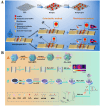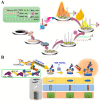Overview of the Design and Application of Photothermal Immunoassays
- PMID: 39409498
- PMCID: PMC11479306
- DOI: 10.3390/s24196458
Overview of the Design and Application of Photothermal Immunoassays
Abstract
Developing powerful immunoassays for sensitive and real-time detection of targets has always been a challenging task. Due to their advantages of direct readout, controllable sensing, and low background interference, photothermal immunoassays have become a type of new technology that can be used for various applications such as disease diagnosis, environmental monitoring, and food safety. By modification with antibodies, photothermal materials can induce temperature changes by converting light energy into heat, thereby reporting specific target recognition events. This article reviews the design and application of photothermal immunoassays based on different photothermal materials, including noble metal nanomaterials, carbon-based nanomaterials, two-dimensional nanomaterials, metal oxide and sulfide nanomaterials, Prussian blue nanoparticles, small organic molecules, polymers, etc. It pays special attention to the role of photothermal materials and the working principle of various immunoassays. Additionally, the challenges and prospects for future development of photothermal immunoassays are briefly discussed.
Keywords: immunoassays; nanozymes; noble metal nanomaterials; photothermal.
Conflict of interest statement
The authors declare no conflicts of interest.
Figures






















Similar articles
-
New photothermal immunoassay of human chorionic gonadotropin using Prussian blue nanoparticle-based photothermal conversion.Anal Bioanal Chem. 2019 Oct;411(26):6837-6845. doi: 10.1007/s00216-019-02049-w. Epub 2019 Aug 30. Anal Bioanal Chem. 2019. PMID: 31471682
-
Overview of Gas-Generating-Reaction-Based Immunoassays.Biosensors (Basel). 2024 Nov 28;14(12):580. doi: 10.3390/bios14120580. Biosensors (Basel). 2024. PMID: 39727844 Free PMC article. Review.
-
Overview of the Design and Application of Dual-Signal Immunoassays.Molecules. 2024 Sep 25;29(19):4551. doi: 10.3390/molecules29194551. Molecules. 2024. PMID: 39407482 Free PMC article. Review.
-
In situ amplified photothermal immunoassay for neuron-specific enolase with enhanced sensitivity using Prussian blue nanoparticle-loaded liposomes.Analyst. 2020 Jun 15;145(12):4164-4172. doi: 10.1039/d0an00417k. Analyst. 2020. PMID: 32369047
-
A novel "mix-response" biosensor for colorimetric and photothermal dual-mode detection of sulfide ions in food based on silver-doping Prussian blue nanoparticle.Talanta. 2024 Nov 1;279:126493. doi: 10.1016/j.talanta.2024.126493. Epub 2024 Jul 5. Talanta. 2024. PMID: 39018946
References
-
- Pan R., Li G., Liu S., Zhang X., Liu J., Su Z., Wu Y. Emerging nanolabels-based immunoassays: Principle and applications in food safety. TrAC-Trend. Anal. Chem. 2021;145:116462–116482. doi: 10.1016/j.trac.2021.116462. - DOI
Publication types
MeSH terms
Substances
Grants and funding
LinkOut - more resources
Full Text Sources

